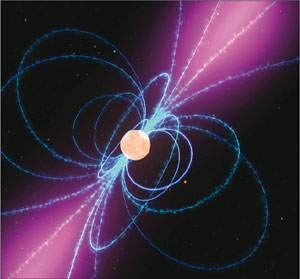The first highlight of the recently launched Fermi Gamma-Ray Space Telescope is the discovery of a new type of object: a gamma-ray pulsar without detectable pulsations at radio, optical or X-ray wavelengths. Scientists think that most of the unidentified gamma-ray sources in the Milky Way could be such young pulsars.

Image credit: NASA.
The Gamma-Ray Large Area Space Telescope (GLAST) renamed in honour of Enrico Fermi after a successful launch on 11 June, is already living up to expectations (CERN Courier November 2008 p13). In less than two months it has gathered more than twice as many photons from the supernova remnant CTA 1 than its predecessor of the 1990s, the Energetic Gamma-Ray Experiment Telescope (EGRET) aboard the Compton Gamma-Ray Observatory.
With 900 gamma-ray photons at energies of more than 100 MeV, the Fermi collaboration has pinpointed the source inside the remnant and determined a pulsation period of 315.86 ms with an increase in period of 3.614 × 10–13 s every second. This is a great achievement, with astonishing precision, considering that the telescope was still in the commissioning phase during part of the observation and that the photons enter the detector one by one at a rate of only about one per minute.
The derived position of this gamma-ray pulsar locates it with the X-ray source RX J0007.0+7303 which was first detected by the Röntgen Satellite (ROSAT) and reobserved by the Chandra and XMM-Newton missions. No evidence of pulsation is found in those X-ray data and the source remains undetected in deep optical and radio observations. These properties are unique compared with those of the nearly 1800 catalogued pulsars that were mostly found through their pulses at radio wavelengths.
The pulsar phenomenon arises from a misalignment of the magnetic and spin axes of a neutron star – the crushed core left behind when a massive star explodes. A pulse is detected on every rotation when the emission beam from the magnetic pole intercepts the line of sight. The absence of radio, optical and X-ray pulses from the source in CTA 1 suggests that the emission beam is narrow enough never to point towards the Earth. However, a wider gamma-ray beam, in the order of 1 steradian, could explain the pulsed gamma-ray radiation detected by the Fermi space telescope.
The measured spin-down rate of the pulsar indicates an age of 14,000 years, which is in good agreement with the estimated age of 5000 to 15,000 years for the supernova remnant. The derived neutron star magnetic field of about 109 T at its surface is quite high for a normal pulsar, but still about a hundredth of that of magnetars (CERN Courier June 2005 p12).
Located about 4600 light-years away in the constellation Cepheus, this gamma-ray pulsar is just at the edge of the error circle of an unidentified EGRET source. The association of the pulsar with this previously observed gamma-ray source is confirmed by a consistent brightness. There are about 75&nsbp;similar EGRET sources near the plane of the galaxy that are not yet identified. The scientists of the Fermi collaboration think that most of these sources – often associated with supernova remnants or star-forming regions – could be similar young pulsars emitting pulses only at gamma-ray energies. If this is correct, there should be many new discoveries in the months to come thanks to the high sensitivity of the Fermi detector.
Further reading
A A Abdo et al. 2008 Science Express.
DOI: 10.1126/science.1165572.







